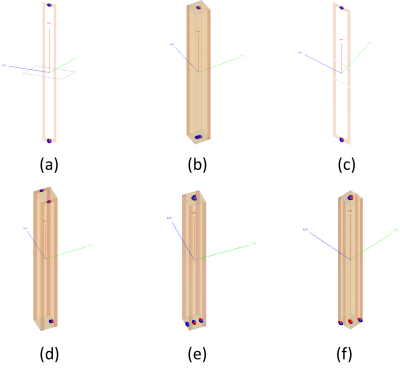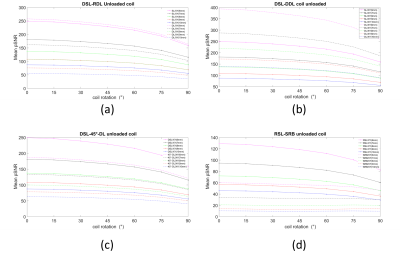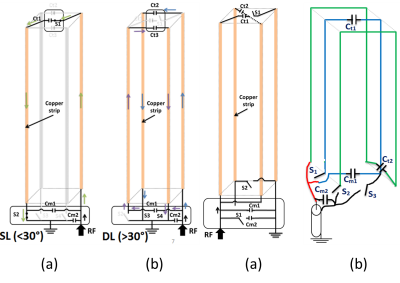4020
Human colon imaging: simulation of novel SwiM RE-coils1Univ Lyon, INSA-Lyon, Université Claude Bernard Lyon 1, UJM-Saint Etienne, CNRS, Inserm, CREATIS UMR 5220, U1206, F-69100, Lyon, France, 2GE Healthcare, Buc, France, 3GE Healthcare, Aurora, OH, United States
Synopsis
Coil-loop geometries were defined and simulated on electromagnetic (EM) software FEKO. Image intensity distribution was evaluated for different orientations with respect to B0. Overall, single loop and double loop with opposite current show complementary results. The switch between these two loops could be realized using MEMS (Micro Electro-Mechanical System) switches. This can reduce the dependency of the coil-sensitivity to its orientation with respect to B0 and can lead to the development of SwiM RE-coils (SWItches MEMS for Reconfigurable Endoluminal coils).
Introduction
Nowadays, colorectal cancer is one of the most common cancers in the world1. MRI is used thanks to several developments in particular in terms of the use of external array coils2. Unfortunately, improvements are still insufficient for bowel and colon wall imaging. The value of endoluminal imaging (high local SNR) has already been demonstrated3,4 using a single loop geometry. The main limitation is related to the required coil navigation within the colon leading to sensitivity-map variations with coil-orientations with respect to the main magnetic field (B0) when the coil-axis is not aligned with B05.The goal of this work is to investigate a reconfigurable endoluminal coils design based on complementary geometries able to atone for adverse effects of coil-orientation (regarding B0). To this end, numerical simulations were carried out to determine the radial sensitivity patterns of the individual unloaded coils. The reconfiguration of the coil-design could be achieve using Micro Electro-Mechanical System (MEMS)6.
Method
In a previous study7, endoluminal diagonal rectangular single (SL) and double (DL) loop geometries were defined, on a parallelepipedic volume (5x5x47 in mm), and evaluated in terms of B1 intensity and radial uniformity distribution. However, resistance losses and phantom effects were not taken into consideration. To follow up on this work, electrical resistance losses (R) (Fig. 1) were introduced and pSNR (proportional SNR) were compared following the proportional relation:$$pSNR=µ_0 \frac{H_{1x,y}}{I\sqrt{R}}$$
Different geometries were first defined (Fig. 1): Rectangular Single Loop (RSL), Diagonal Single Loop (DSL), Specific rectangular butterfly (SRB), Rectangular Double Loop (RDL), Diagonal Double Loop (DDL), 45°-double loop (45-DL). DL were based on opposite current direction. Then, they were simulated on electromagnetic (EM) software FEKO based on the full-wave numerical Method of Moment (MoM) permitting the current distribution modeling and thus estimation of the magnetic field components H1. Using Matlab software, H1 components were calculated for different coil-loop orientations with respect to the magnetic field field (aligned with z-axis) by using 3D rotation matrices. Angles around X/Y axes were chosen from 0 to 90/90° with 15/15° step. Slice orientation was always considered as orthogonal to the coil orientation.
The electrical loss resistance (R) was estimated from simulated unloaded quality factors (Qu) derived from S11 responses at -3 dB bandwidth. Using Matlab software, mean and standard deviation values of pSNR were calculated on concentric circles between 6 and 10 mm radius from the coil center (colon wall location) to analyze the pSNR provided by each endoluminal loop geometry. Finally, according to these results, MEMS reconfigurable endoluminal coil designs were proposed.
Results
In any cases, mean pSNR values dropped-off rapidly with distance from the coil-center. Below 7 mm, the RDL exhibited mean pSNR values higher than DSL. At 7 mm and higher, mean pSNR of DSL were higher than those of RDL geometry (Fig. 2-a). In the contrary, the DSL provided the lowest and the highest values (for all orientations) against the DDL (Fig. 2-b) and the 45°-DL (Fig. 2-c), respectively. Similarly, the RSL provided the highest values against the SRB (Fig. 2-d).The standard deviation (std) results showed smaller variations with the DSL for all orientations bellow 8 mm against the RDL. At 9 mm and higher, the DSL orientation angles inferior to 30-35° while the RDL showed the lowest std-values beyond (Fig. 3-a). In the contrary, the DDL provided the highest std-values against the DSL for all orientations (Fig. 3-b) while the 45-DL and the SRB provided the lowest std-values for high orientations (Fig. 3-c,d). std values of the SRB geometry remain almost stable.
Discussion
The rapid decrease of sensitivity is the characteristic of all surface coils. Despite that, mean pSNR values are always superior to at least 25 for all coils which is sufficient for endoluminal imaging (>21). The highest mean pSNR of the DSL against the RDL are due to the larger loop width DSL compared to RDL with half current intensity circulating in each loop.DSL demonstrates better performances with lowest std pSNR values for low orientations (<30-35°) while the DRL demonstrates better performances (better radial-uniformity) for high orientations. SRB and 45°-DL are interesting for the very high angle orientations.
According to these results, several combined complementary geometries can be derived to design endoluminal coils with reduced dependency between coil-sensitivity and coil-orientation. This can be achieved by using MEMS switches to change the current pathway between coil-conductors. Some geometries of the SwiM RE-coils (SWItches Mems for Reconfigurable Endoluminal coils) are illustrated in the (Fig. 4) .
Each SwiM RE-coil geometry must be decoupled from the transmitter coil (body coil) during the transmit phase to avoid the mutual inductance between RF resonating coils. MEMS active decoupling for endoluminal coils was already demonstrated8.
Conclusion
In conclusion, EM simulations were used to demonstrate that it is possible to reduce the dependency of the sensitivity to coil orientation through SwiM RE-coils based on complementary configurations. A particularity of this work is the use only one receive channel to avoid the EM coupling between channels very constrain volume. Besides, using open MEMS in series remove resonances. As perspectives, SwiM RE-coil prototype may be built and characterized on both experimental bench and imaging set-up.Acknowledgements
Authors would like to thank GE Healthcare Inc. and ANRT to fund this project. This work was conducted in the scope of the LABEX PRIMES of University of Lyon (ANR-11-LABX-0063), within the program "Investissements d'Avenir" (ANR-11-IDEX-0007) operated by the French National Research Agency (ANR).References
1. Ferlay J, Colombet M, Soerjomataram I, et al.: Estimating the global cancer incidence and mortality in 2018: GLOBOCAN sources and methods. Int J Cancer 2019; 144:1941–1953.
2. Roemer PB, Edelstein WA, Hayes CE, Souza SP, Mueller OM: The NMR phased array. Magn Reson Med 1990; 16:192–225.
3. Dorez H, Sablong R, Canaple L, et al.: Endoluminal high-resolution MR imaging protocol for colon walls analysis in a mouse model of colitis. Magn Reson Mater Phys Biol Med 2016; 29:657–669.
4. Beuf O, Pilleul F, Armenean M, Hadour G, Saint-Jalmes H: In vivo colon wall imaging using endoluminal coils: Feasibility study on rabbits. J Magn Reson Imaging JMRI 2004; 20:90–6.
5. Atalar E, Bottomley PA, Ocali O, et al.: High resolution intravascular MRI and MRS by using a catheter receiver coil. Magn Reson Med 1996; 36:596–605.
6. Spence D, Aimi M: Custom MEMS switch for MR surface coil decoupling. In Proc 23rd Annu Meet ISMRM Tor Can; 2015:0704.
7. Raki H, Tse-Ve-Koon K, Souchay H, Robb F, Lambert S, Beuf O: Design of a reconfigurable endoluminal coil using MEMS switches. In 27th Annu Meet ISMRM. Montréal, Canada; 2019.
8. Raki H, Saniour I, Robb F, et al.: Comparison of single-loop endoluminal receiver coils based on serial or parallel active decoupling circuits using controllable MEMS switches. In Jt Annu Meet ISMRM-ESMRMB 2018. Paris, France; 2018.
Figures



